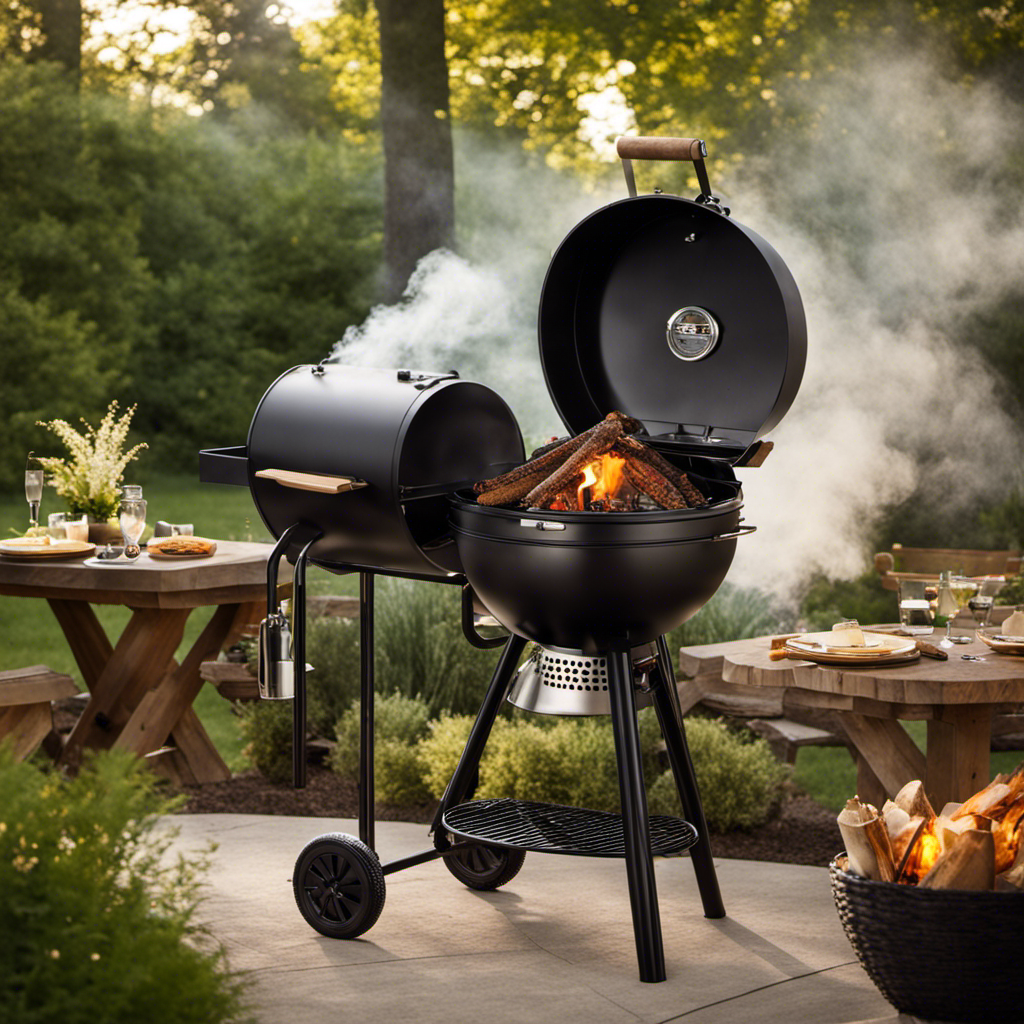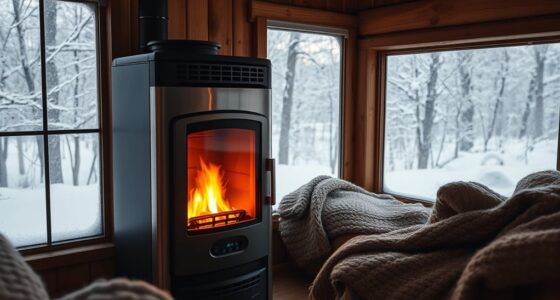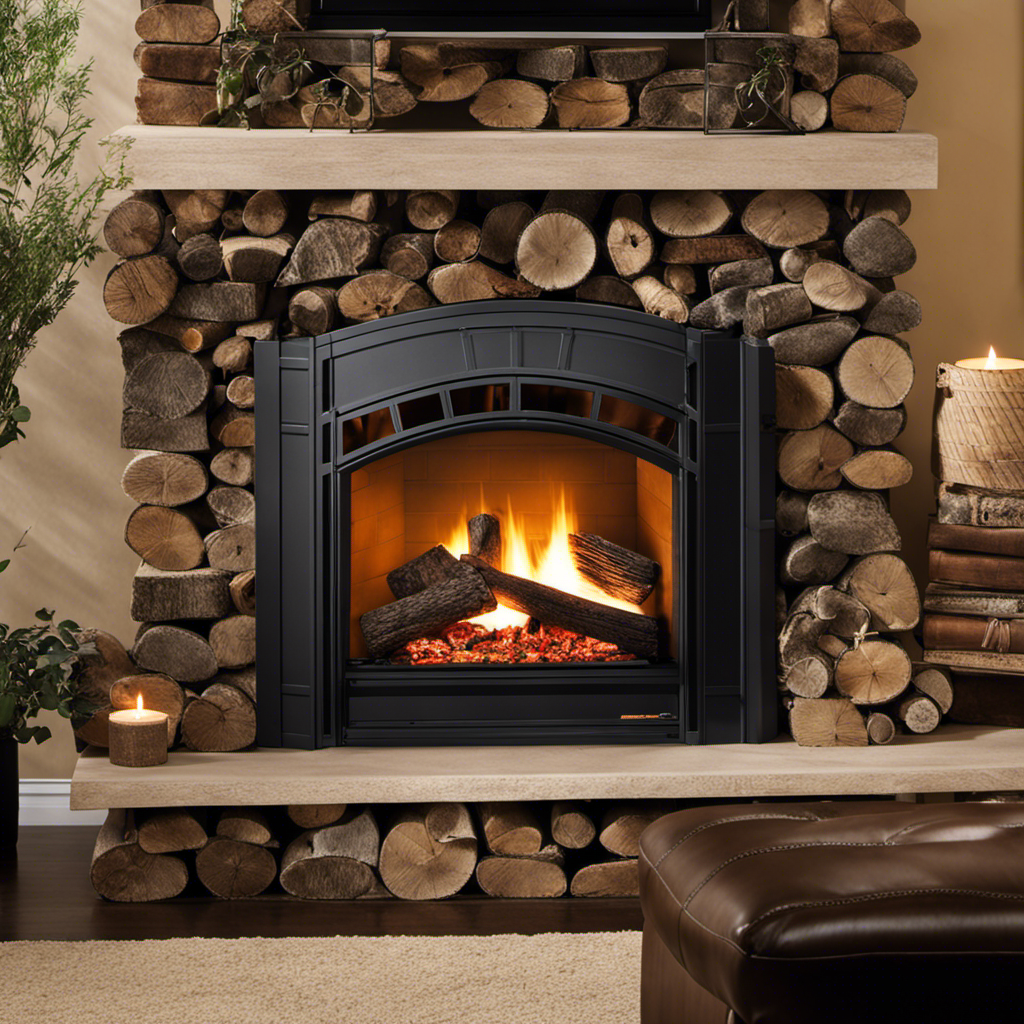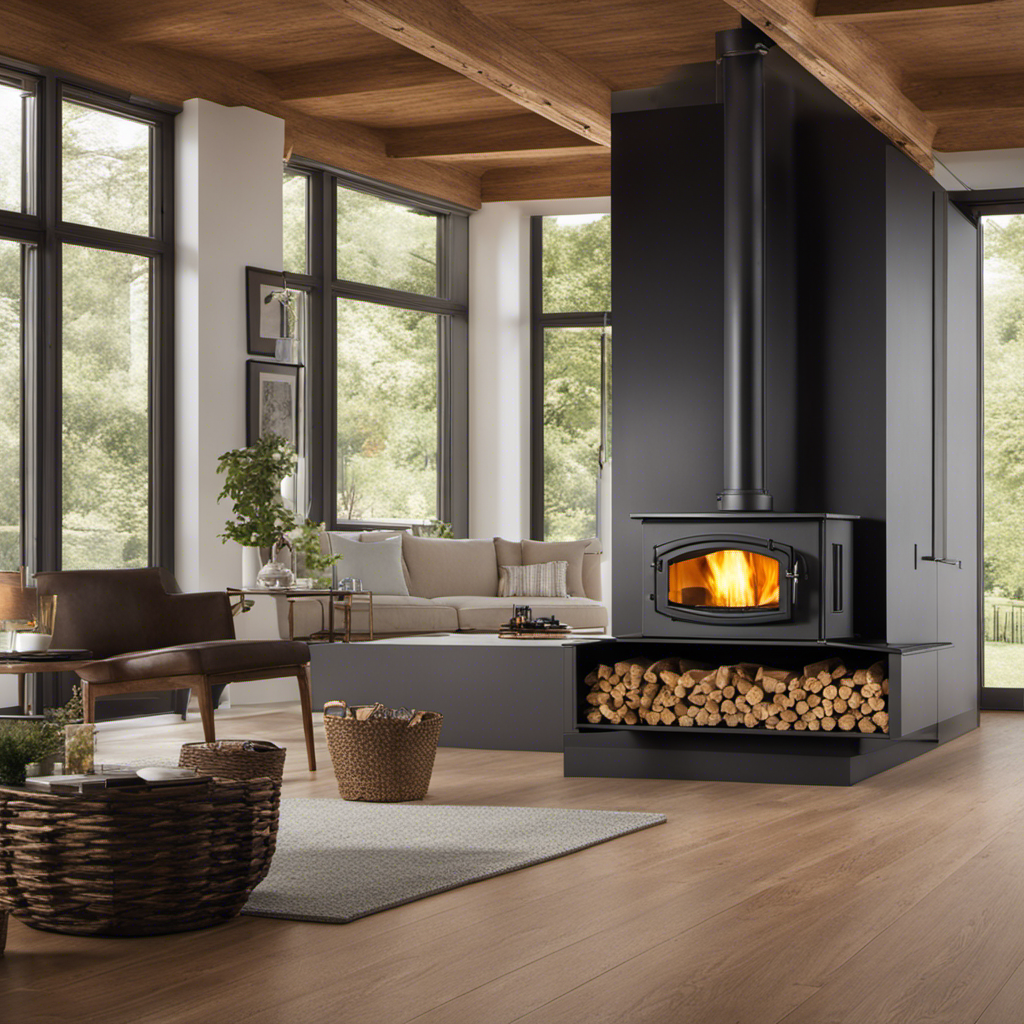As a seasoned enthusiast of barbecue, I’ve discovered that the secret to attaining extraordinary flavor in my grilling pursuits is to use a wood pellet smoker.
Did you know that wood pellet smokers can infuse your food with a delicious smoky taste, while also offering precise temperature control?
In this article, I’ll guide you through the process of choosing, assembling, and using a wood pellet smoker, sharing my tried-and-true techniques and tips along the way.
Get ready to elevate your grilling game and impress your friends and family with mouthwatering, perfectly smoked dishes.
Key Takeaways
- Consider factors such as size, temperature range, and ease of use when choosing and assembling a wood pellet smoker.
- Select the best wood pellets for distinct flavors by using different types of wood and blending hardwood pellets.
- Follow the manufacturer’s instructions for assembly and take your time to avoid mistakes.
- Season the wood pellet smoker to prevent rust, enhance flavor, and ensure even distribution of heat and smoke.
Choosing the Right Wood Pellet Smoker
When choosing the right wood pellet smoker, it’s important to consider factors such as size, temperature range, and ease of use. As an experienced grill enthusiast, I have tried various wood pellet smoker brands and have found that each one has its own unique features and benefits.
Some popular brands include Traeger, Camp Chef, and Green Mountain Grills. Additionally, it’s crucial to select the best wood pellets to use in your smoker. Different types of wood, such as hickory, mesquite, or apple, can impart distinct flavors to your food. Personally, I prefer using a blend of hardwood pellets for a well-rounded smoky flavor.
Now that you have chosen your wood pellet smoker, let’s move on to assembling and preparing it for your next delicious barbecue adventure.
Assembling and Preparing Your Wood Pellet Smoker
Before assembling your wood pellet smoker, make sure you have all the necessary tools and parts ready. Assembling a wood pellet smoker may seem daunting, especially for beginners, but with the right techniques and some helpful tips, it can be an enjoyable and rewarding experience. Here are four key points to keep in mind:
-
Follow the instructions: Carefully read the manufacturer’s manual and follow the step-by-step assembly instructions. This will ensure that you assemble your smoker correctly and avoid any potential issues.
-
Take your time: Rushing through the assembly process can lead to mistakes. Take your time to understand each step and double-check your work to ensure everything is securely in place.
-
Use the right tools: Having the right tools handy will make the assembly process much smoother. A screwdriver, pliers, and a socket wrench are typically needed for most wood pellet smokers.
-
Seek assistance if needed: If you’re unsure about any step or encounter difficulties, don’t hesitate to ask for help. Reach out to the manufacturer’s customer support or consult online forums for guidance.
Once your wood pellet smoker is assembled, it’s time to move on to the next step: seasoning your smoker to enhance its performance and prolong its lifespan.
Seasoning Your Wood Pellet Smoker
When it comes to using a wood pellet smoker, one of the most important steps is seasoning the equipment.
Seasoning is the process of coating the inside of the smoker with oil to prevent rust and create a non-stick surface.
Not only does seasoning protect your smoker, but it also enhances the flavor of your food by infusing it with a smoky essence.
Let me share with you the benefits of seasoning and explain the process in detail.
Benefits of Seasoning
One of the benefits of seasoning wood pellets is that it enhances the flavor of the food. As an experienced wood pellet smoker enthusiast, I can confidently say that the advantages of seasoning are truly remarkable.
When you season your wood pellets, it allows the natural oils and resins to burn off, resulting in a clean, pure smoke that infuses your food with a delicious smoky flavor. Not only does the seasoning process improve the taste, but it also helps to prevent any unpleasant flavors or odors from affecting your food.
To ensure the best results, it’s essential to follow a few tips and tricks. Now, let’s delve into the seasoning process explained and discover how to get your wood pellet smoker ready for the ultimate smoking experience.
Seasoning Process Explained
The benefits of seasoning wood pellets include enhancing the flavor of the food. When it comes to creating delicious smoked dishes, the seasoning process is crucial to achieving the desired smoke flavor profiles. Here are a few key points to consider during the seasoning process:
-
Choosing the right wood: Different types of wood impart different flavors to the food. Experiment with various wood varieties to find the perfect match for your taste preferences.
-
Proper storage: Ensure that the wood pellets are stored in a dry and well-ventilated area to prevent moisture absorption, which can lead to uneven burning and undesirable flavors.
-
Time and patience: Seasoning wood pellets requires time for the flavors to develop. Allow the pellets to rest for at least a week before using them.
-
Avoiding common mistakes: Keep in mind that using wet or green wood pellets can result in excessive smoke and bitter flavors. Additionally, over-soaking the pellets can lead to poor combustion and reduced smoke production.
Now that the wood pellets are properly seasoned, it’s time to move on to the next step: loading and igniting them for that perfect smoky flavor.
Loading and Igniting the Wood Pellets
When it comes to loading and igniting wood pellets in a smoker, there are a few key techniques that can make a world of difference.
Proper pellet loading techniques ensure even distribution and maximize heat output.
Additionally, the ignition method plays a crucial role in achieving optimal heat and getting those pellets burning efficiently.
As someone who has been using wood pellet smokers for years, I’m passionate about sharing my knowledge and experience on these topics to help others elevate their grilling game.
Pellet Loading Techniques
To load your wood pellet smoker, you’ll want to make sure you’re using the correct technique. Proper pellet loading is crucial for ensuring optimal performance and delicious results. Here are three key factors to consider when loading your wood pellet smoker:
-
Pellet Storage: It’s important to store your pellets in a dry and cool place to maintain their quality. Moisture can affect the pellets’ combustion, leading to inconsistent heat and smoke production. Ensure your pellets are stored in airtight containers or sealed bags to prevent moisture absorption.
-
Pellet Quality: The quality of your pellets plays a significant role in the flavor and efficiency of your smoker. High-quality pellets are made from pure hardwood without any fillers or additives. Look for pellets that have a low ash content and are made from dense wood for a clean burn and robust flavor.
-
Proper Distribution: When loading the pellets into your smoker, ensure an even distribution across the entire hopper. This will ensure a consistent heat and smoke output throughout your cooking process.
Now that you have loaded your wood pellet smoker correctly, let’s dive into the various ignition methods for pellets.
Ignition Methods for Pellets
Now that you’ve loaded your wood pellet smoker correctly, let’s explore the different ways to ignite the pellets.
Starting fires with wood pellets can be done using various lighting tools, each with its own advantages. My personal favorite is using an electric starter. It’s quick, efficient, and eliminates the need for lighter fluid or matches. Simply plug it in, place it in the pellets, and watch as they ignite within minutes.
Another popular method is using a propane torch. This provides a powerful flame that quickly lights up the pellets, ensuring a fast start.
Whichever method you choose, make sure to follow the manufacturer’s instructions for your specific smoker.
Now, with the pellets ablaze, let’s move on to achieving optimal heat for the perfect smoking experience.
Achieving Optimal Heat
Once the pellets are ignited, it’s important to monitor and adjust the temperature to achieve optimal heat for the perfect smoking experience. Maintaining the temperature is crucial because it ensures that your food cooks evenly and retains its moisture. It also plays a significant role in achieving that delicious, smoky flavor we all love.
As an experienced wood pellet smoker enthusiast, I have learned that controlling the temperature is an art. It requires constant attention and a keen understanding of your smoker’s settings. By carefully adjusting the airflow and fuel supply, you can fine-tune the temperature to match your desired cooking style.
Controlling the Temperature on Your Wood Pellet Smoker
Maintaining a consistent temperature is crucial when using a wood pellet smoker. Controlling the temperature allows you to achieve the perfect balance of tenderness and smokiness in your meats.
As an experienced pitmaster, I’ve learned that the temperature control is the key to unlocking the full potential of your wood pellet smoker. By adjusting the settings, you can control the intensity of the smoke flavor, ensuring it complements the meat rather than overpowering it.
Whether you’re smoking a brisket or a rack of ribs, the ability to maintain a steady temperature throughout the cooking process is essential for achieving mouthwatering results.
Now, let’s move on to the next section, where we’ll explore how different wood pellet flavors can elevate the taste of your smoked dishes.
Adding Flavor With Wood Pellet Selection
To enhance the flavor of your smoked dishes, you’ll want to select different wood pellet varieties. The type of wood you choose can greatly impact the taste of your meats, adding depth and complexity to every bite. Here are three wood pellet options that will take your smoking game to the next level:
-
Mesquite: Known for its strong and robust flavor, mesquite wood pellets are perfect for bold and savory meats like beef and pork.
-
Apple: For a sweeter and more subtle taste, apple wood pellets are a great choice. They pair well with poultry, fish, and even vegetables.
-
Hickory: A classic choice, hickory wood pellets offer a rich and smoky flavor that works well with a variety of meats, from ribs to brisket.
By experimenting with different wood pellet varieties, you can create unique flavor profiles that will impress even the most discerning palate.
Now, let’s dive into some smoking techniques and tips for perfect results…
Smoking Techniques and Tips for Perfect Results
If you’re looking to achieve perfect results when smoking your meats, remember to control the temperature and keep an eye on the internal temperature of your food.
Smoking is an art, and mastering the techniques will elevate your dishes to new heights.
When it comes to smoke flavors, experimenting with different wood pellet varieties is key. Each type of wood pellet imparts a unique flavor profile to your food. From the rich and smoky flavor of hickory to the sweet and fruity notes of applewood, the possibilities are endless.
By understanding the characteristics of each wood pellet variety, you can create harmonious flavor combinations that will leave your taste buds craving for more.
Now that you’ve learned the essentials of smoking techniques, it’s time to delve into the next important aspect of wood pellet smoker ownership – cleaning and maintaining your equipment.
Cleaning and Maintaining Your Wood Pellet Smoker
Now that you’ve mastered the art of smoking, it’s important to regularly clean and maintain your wood pellet smoker to ensure optimal performance and longevity. Here are some cleaning techniques and a maintenance schedule to keep your smoker in top shape:
-
Cleaning Techniques:
-
Use a wire brush to scrub the grates and remove any food residue.
-
Wipe down the interior and exterior of the smoker with a damp cloth.
-
Maintenance Schedule:
-
Clean the smoker after each use to prevent buildup and maintain flavor.
-
Deep clean the smoker every few months by removing and cleaning the grates, drip pan, and ash trap.
-
Check and clean the auger and hopper to ensure proper pellet flow.
Regular cleaning and maintenance will not only enhance the taste of your food but also extend the life of your wood pellet smoker.
Now, let’s move on to troubleshooting common issues with wood pellet smokers.
Troubleshooting Common Issues With Wood Pellet Smokers
Let’s start by addressing some common issues you may encounter with your wood pellet smoker.
As an experienced user, I have faced my fair share of troubleshooting with these machines, but don’t worry, I’m here to help.
One of the most frustrating problems you may face is pellet feeder issues. Sometimes, the pellets may not be feeding into the firebox properly, causing uneven heat or even a complete shutdown.
To fix this, start by checking if there are any blockages in the feeder tube. Clearing any debris or obstructions should get the pellets flowing again. Additionally, make sure the auger is clean and functioning correctly. If needed, lubricate it to prevent any sticking.
Can I Use Wood Pellet BBQ Techniques for Smoking?
Yes, you can use wood pellet bbq operation techniques for smoking. By adjusting the temperature and smoke settings on your wood pellet smoker, you can enjoy the convenience of using pellets while still achieving delicious smoked flavor in your meats.
Frequently Asked Questions
Can I Use Regular Wood Chips Instead of Wood Pellets in a Wood Pellet Smoker?
Yes, you can use regular wood chips instead of wood pellets in a wood pellet smoker. However, there are pros and cons to consider. Wood chips may burn faster and require more frequent refills, but they can add different flavors to your food. Experiment and find what works best for you!
How Do I Know When the Wood Pellets Are Fully Ignited and Ready for Smoking?
To know when wood pellets are fully ignited for smoking, I wait for a steady flow of smoke and a consistent flame. If there’s trouble igniting, check for proper airflow, dry pellets, or a malfunctioning igniter.
What Is the Recommended Temperature Range for Smoking Different Types of Meats?
The recommended smoking temperatures for different types of meats can vary, but generally, a range of 225-250°F is ideal. Pairing the right wood pellet flavors with your meats can enhance the flavor and create a delicious smoky profile.
Can I Use the Leftover Ashes From the Wood Pellets as a Fertilizer for My Garden?
Yes, you can use the leftover ashes from wood pellets as a fertilizer for your garden. Wood pellet ash contains nutrients like potassium and phosphorus that can benefit your plants, promoting healthy growth and providing essential minerals.
Are There Any Specific Safety Precautions I Should Take When Using a Wood Pellet Smoker?
When using a wood pellet smoker, it’s important to prioritize safety. Taking proper ventilation measures and following safety precautions will ensure a smooth and enjoyable smoking experience. Stay safe and enjoy the delicious flavors!
Conclusion
In conclusion, using a wood pellet smoker is a game-changer for any BBQ enthusiast.
With the right smoker and a little know-how, you can achieve mouthwatering results every time.
From assembling and seasoning your smoker to loading and igniting the wood pellets, controlling the temperature, and adding flavor with the perfect wood pellet selection, there’s a lot to learn.
But don’t worry, with practice and patience, you’ll become a pro in no time.
So grab your apron, fire up that smoker, and get ready to impress your friends and family with your smokin’ skills!











